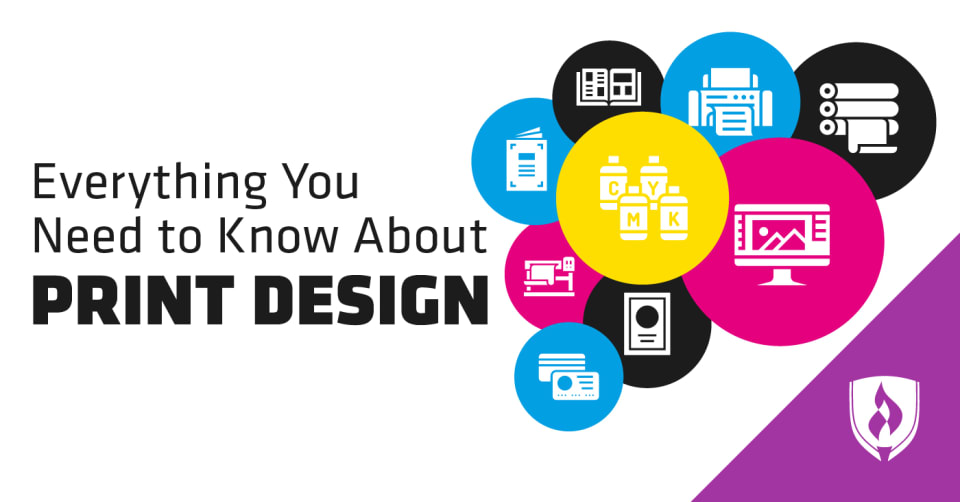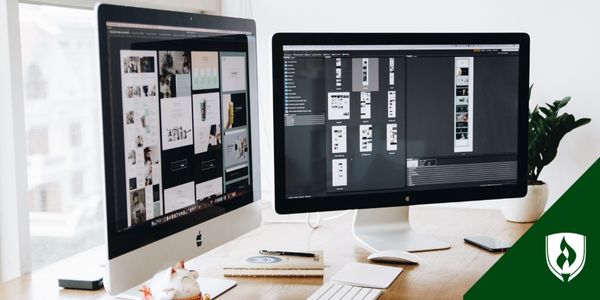
You think you know the basics of what graphic designers do. They use design principles and special software to design logos, websites and other digital content like infographics. That’s all there is to it, right?
Not so fast. Digital graphic design work may get most of the spotlight, but that’s doesn’t mean print design is obsolete. There are many types of print design that are still a necessary part of the design field, and incoming graphic designers need to have sharp print design skills to be marketable in the workforce.
So what is print design and why does it still matter? We spoke with design experts to uncover the answers about this often-overlooked aspect of graphic design.
What is print design and why does it still matter?
Print designs appear on printed media like business cards, billboards or brochures rather than digital spaces like websites. Just like digital designs, the goal of print design is to use visual graphics to communicate a specific message to viewers.
At first glance it might seem like print design is a rarity. If you take a closer look, however, you’ll realize that you’re surrounded by print designs every day. People regularly encounter print designs as they move throughout their day, making this area of graphic design important to efforts like brand marketing and advertising campaigns.
“Tons of print collateral and mediums are still very relevant today,” says Dana S. Hewling, owner and creative director at B.ID LLC. “People should be reached in both the digital world and in the real world.”
Graphic design in any form is about communication. Think of print design as just another avenue for reaching your audience and sharing your message. “Until everyone can digitally project everything, print will still be needed,” Hewling says. “You should have an understanding of how to produce strong, captivating print pieces that help build stronger connections with your target.”
It’s important to remember that print design is also evolving alongside digital technology. Mark Krenn, founder of Coastal Creative, points out that experiential design and marketing “bridge the gap between online and offline worlds” through immersive print design. With the advent of new technology that merges print design with the digital space, it’s clear that print design isn’t going to become irrelevant anytime soon. Advertisers want comprehensive campaigns that reach potential customers at all points—and that means a blend of digital and print advertising is likely to remain a viable approach.
Types of print design
Print design is all around us, often in ways we take for granted. Traditional business marketing still relies on print media to spread awareness of their brand. Print design also takes center stage in industries like publishing, where a well-designed cover can make a huge difference in book sales.
These are some of the types of print design to be aware of:
- Business cards
- Branded packaging, labels and shopping bags
- Brochures
- Billboards
- Book covers and interiors
- Magazines and newspapers
- Signage
- Stationery
- Greeting cards and invitations
- Calendars
- Posters
- Menus
- Banners
Print design vs. digital design
Print design and digital design are similar in many ways. They share the common goal of communicating with a target audience, and the basic principles of design hold true for both print and digital mediums. However, creating print designs differs from digital designs in a few key ways.
“Print designers need to be experts at working within specific bounds and ensuring the final product is absolutely pixel perfect,” says Krenn. “This differs from digital design work because with digital design, any mistakes and errors have minimal correction costs and can be easily fixed.”
This brings up another point: Print design is costly in a way that digital design isn’t. “An error on a printed job? That can cost up to thousands of dollars in lost material cost and require a full redo. There are hard fixed costs with printing design that don’t come close in digital,” Krenn says.
Print designers also have the added challenge of working with narrow parameters. There’s a limit to the size of a banner or business card, or to the number of words that will fit on a magazine spread. Print designers need to be aware of these boundaries at all times.
The value of print design skills in the workforce
You can imagine that graphic designers need some special skills up their sleeves to keep up with the particular challenges of print design. Succeeding in this area of design includes knowing your way around a wider range of design software and understanding the basics of print design principles.
For example, print designers must always be aware of the resolution of their design to ensure that it prints at the highest quality, advises Hewling. “You must be using the right tools and assets for the job at hand. Not everything is Photoshop® in the world of print,” Hewling says. She recommends mastering Adobe Illustrator® for large-format print pieces and Adobe InDesign® for text-heavy layouts like books or magazines.
These skills may be specific to print design, but they’re applicable to careers across the graphic design industry. “Working offline can help focus a designer and make them think more creatively, which can then be transitioned to digital,” Krenn says. “This will help the designer rapidly improve their skills and show a diversity of work in their portfolio.”
Could print design be a relevant part of your career?
If you’re considering a career in graphic design, you might find yourself with print design as an important part of your job. Wondering whether the graphic design field has any other surprises to offer? Discover these 8 Types of Graphic Design Jobs You May Not Know About. Additionally, explore what makes a good logo.
Adobe Photoshop, Illustrator and InDesign are registered trademarks of Adobe Inc.
Related Articles:




